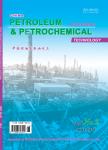Numerical Simulation of Optimization of Mixing Tank for Residue Upgrading Reactor
Numerical Simulation of Optimization of Mixing Tank for Residue Upgrading Reactor作者机构:SINOPEC Research Institute of Petroleum Processing
出 版 物:《China Petroleum Processing & Petrochemical Technology》 (中国炼油与石油化工(英文版))
年 卷 期:2019年第21卷第2期
页 面:110-117页
核心收录:
学科分类:0820[工学-石油与天然气工程] 0821[工学-纺织科学与工程] 0808[工学-电气工程] 08[工学] 0817[工学-化学工程与技术] 0807[工学-动力工程及工程热物理] 0827[工学-核科学与技术] 0703[理学-化学] 0802[工学-机械工程] 0702[理学-物理学] 0801[工学-力学(可授工学、理学学位)]
基 金:supported by the Major Science and Technology Project of SINOPEC (ST18012-4)
主 题:liquid-liquid mixing impellers numerical simulation critical rotation speed
摘 要:For studying the mixing tank for RMAC (residue upgrading to maximize asphaltene conversion) reactor, the CFD simulation was employed to simulate the flow field in the mixing tank. The dispersion of liquid-liquid phase in the mixing tank and the power of turbines were investigated. The simulation results showed that compared with the original doublelayer propeller, the A310-swept double-layer impellers could reduce the liquid heterogeneous degree by 27.5% and the stirring power by 3.25%. The influence of rotation speed on the heterogeneous degree and stirring power was investigated, and the critical rotation speed was obtained. The optimal rotation speed was determined to be 240 r/min. The heterogeneous degree was 0.19 and the minimum stirring power was 10.89 W. By optimizing the impeller selection and process conditions, the overall performance of the mixing tank could be significantly improved.



